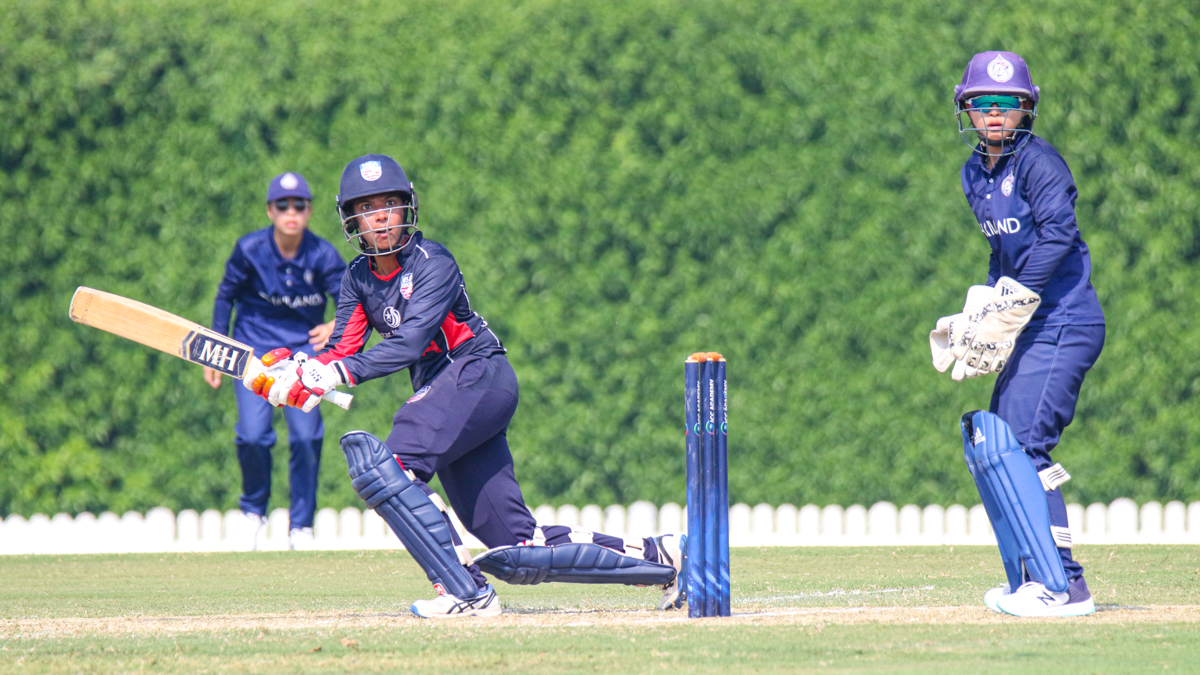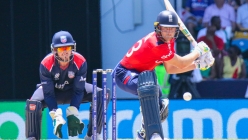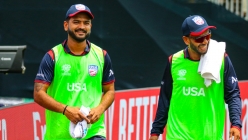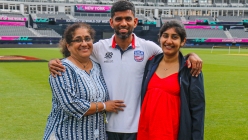Views
USA Cricket: 2022 USA Women in the UAE Tour Review
2022 Oct 07 by DreamCricket USA

By Peter Della Penna (Twitter @PeterDellaPenna)A thorough examination of the USA Women's team performances looking at each discipline during their eight-match tour of the UAE in September.
Photo credit: Peter Della Penna
Batting: D
USA had one of the standout batters in the UAE last month in the form of captain Sindhu Sriharsha, who scored 205 runs at an average of 34.17 with two half-centuries and finished ninth overall in runs within the Women's T20 World Cup Qualifier. However, only one other batter passed 100 runs for USA on tour (Lisa Ramjit with 115 at an average of 28.75) and only two other players had a batting average in the double digits (Mahika Kandanala at 11.75 and Suhani Thadani at 13.00).
Batting was supposed to be a strength for USA on this tour and on paper the batters actually were statistically much better than what USA produced at the 2019 Women’s T20 World Cup Qualifier in Scotland. USA passed 100 in four of eight matches on tour this past September in the UAE, five if the unofficial warm-up match against Thailand is included. USA never passed 100 runs as a team on the 2019 Women's T20 World Cup Qualifier tour of Scotland, and were bowled out for a low of 46 by Bangladesh. Nobody passed 100 runs individually for USA on tour in Scotland and only one player (Nadia Gruny) had more than 50 runs on tour in 2019. The problem is that not only did USA's batting get better compared to 2019, but every other team in this year's qualifier also improved their batting in the three years since the last qualifier and did it better in relative terms too.
USA trialed numerous opening combos, but none of them seemed to work as USA’s highest opening partnership of the tour was good for just 25 runs, coming in the last match between Ramjit and Disha Dhingra. The bulk of USA’s middle-order, which has looked confident in domestic events, had trouble adjusting to much higher class of bowler at international level. Collectively, USA had one half-century partnership (a USA record 91-run partnership between Sriharsha and Ramjit against Bangladesh). Their opponents had six half-century partnerships, including the highest partnership of the Qualifier between Murshida Khatun and Nigar Sultana of Bangladesh, who added an unbeaten 138 runs for the second wicket.
USA had two major issues on the batting side: poor running between the wickets and lack of power. USA were runout 19 times across eight official T20Is. By comparison, they only effected two runouts in the field against their opponents. Their ability to judge a run both inside the circle and outside of it was poor, limiting their ability to turn ones into twos and twos into threes. Zimbabwe ran three threes against USA, which is more than USA had across eight matches in the UAE (two). Thailand were able to run a three as well as an all-run four against USA, highlighting the difference in awareness and recognition of weak fielders that USA was able to make in the middle compared to their opponents.
In terms of USA’s lack of power, they were the only team in the UAE over the course of the month of September that did not hit a six. Over the course of USA’s entire Women’s T20I history, they have only hit four sixes – two by Erica Rendler against PNG in Scotland in 2019, and one each by Sindhu Sriharsha and Uzma Iftikhar which both came in the same match against Canada in Lauderhill in May 2019. Tanya Ruma of PNG hit seven sixes during the five matches in the 2022 Qualifier in the UAE, highlighting how poor USA is historically in this area. Even in terms of general boundary striking, USA is way behind and relied heavily on Sriharsha. The USA captain struck 22 of USA’s 63 boundaries on tour, accounting for 35% of the team output.
Beyond this, USA’s general aggressiveness and strike rotation is poor, in particular during the opening six-over Powerplay. This was exacerbated by regular loss of wickets. USA lost at least three wickets in the Powerplay in five of their eight matches. The other three instances they lost one wicket, meaning they never had a wicketless Powerplay at bat. Their highest score in the first six overs was 34 and their average score was 23 for 3. Part of the flood of early wickets often came as a result of dot ball pressure that led to attempted suicide singles leading to runouts. USA never had fewer than 23 dot balls in the opening six-over Powerplay. That low number came in their only win on tour against UAE at ICC Academy. The most dot balls in the Powerplay came against Thailand (30), a match where USA also had four runouts.
The strike rotation was not much better outside of the Powerplay either. USA never had a match where they scored off more than 50% of their deliveries. They were right on the 50% mark against Bangladesh and in the final match loss to the UAE. Crucially in that game against UAE, two of their 61 dot balls came on free hits following no balls. On the opposite end of the spectrum, USA only had 30 scoring shots against Scotland (more than 70% dot balls), 43 scoring shots vs Papua New Guinea (65% dot balls), and 47 scoring shots against both Thailand and Ireland (61% dot balls). The only consolation USA can take from struggling against these bowling units is that USA was in by far the tougher group in round-robin play, considering that both of the eventual qualifiers to secure a spot in the 2023 Women's T20 World Cup (Bangladesh and Ireland) came out of USA's group.
USA’s shot placement was extremely poor. Very few of the dot balls came on play and misses or defended balls. The overwhelming majority of dot balls came on deliveries that USA’s batters muscled to extra cover, mid-off, mid-on, straight midwicket or back to the bowler on attacking shots. The refusal to attempt shots outside of this orthodox V also hindered USA. The number one scoring shot for USA on tour was the late cut by Sriharsha between backward point and short third. But few players seemed to take the cue and try it themselves, or try to sweep, or come down the pitch at all to use their feet, or alternatively shuffle across their stumps to try to create a better angle to pull or flick behind square leg. It meant that aside from Sriharsha, USA’s strokeplay was predictable, bland, easy to set a field to defend against as USA’s other batters rarely played any shots that forced a change in the field. The tip and run single was also non-existent, once again highlighting USA’s lack of touch and ability to manipulate the field compared to other teams who made a regular habit of stealing runs inside the circle in this manner.
In terms of the lack of aggression in the Powerplay as well as late hitting at the death, the two players USA missed most were Gargi Bhogle (injured after needing surgery to repair a hand/finger fracture at USA Women’s Regionals in Texas) and Holly Charles (included in the original squad submitted to the ICC for the Qualifier but withdrawn due to undisclosed reasons). Bhogle was USA’s best scorer last year at the ICC Americas Qualifier in Mexico and was a consistent boundary scoring option. Charles would have been in the squad primarily for her pace bowling but in recent times has been the only player on the USA domestic radar who has demonstrated any capability to hit sixes at the death (or at any stage of the match for that matter).
USA also dearly missed out on the services of Tara Norris (unavailable due to County Cricket commitments), Jessica Willathgamuwa (ineligible, has not yet satisfied ICC residency requirements), and Pooja Ganesh (not yet 15, which is the minimum age under new ICC eligibility guidelines), who all would have brought enhanced capabilities to USA’s batting lineup in various roles. Ganesh is the most appealing of these on the batting side for her aggression and creativity which others have lacked. She was infamously bowled behind her legs on two occasions at USA Women’s Regionals in Texas when she shuffled too far across her stumps to access the leg side. Those wickets may have looked embarrassing at the time but it was also a consequence of that fact that she was one of the few players willing to explore different scoring options through her footwork in and around the crease, and at the end of the day it led to her being one of the most creative and efficient scorers on display.
The other player absent purely for selection reasons who could have made an impact was Shebani Bhaskar. The former USA vice-captain has the second most boundaries for USA in Women’s T20Is behind only Sriharsha, but she looked like she had zero confidence at USA Women’s Nationals in Texas in August. Not only did it rub off on her batting form, but increasingly to other aspects of her game. On her current form, it was nearly impossible to select her but perhaps being dropped was the wakeup call she needed to get her game back to where it needs to be. Bhaskar is still only 28 so if she can rediscover her form and confidence, she can still be a tremendous asset to USA in the future.
Bowling: C-
USA’s spinners compared respectably with other spinners at the tournament. Bhumika Bhadriraju (8 wickets at 13.75, 5.24 economy rate), Sai Eyyunni (4 wickets at 22.66, 5.23 economy), Ritu Singh (4 wickets at 32.50, 6.67 economy), and Taranum Chopra (4 wickets at 20.50, 6.07 economy), accounted for 20 wickets. Bhadriraju in particular was impressive for continuously challenging batters, daring them to smash her and trusting USA’s boundary fielders to back her up. The same goes for Eyyunni, who was a late arrival but performed very respectably. The extreme slowness of their flight posed problems for many teams.
However, USA’s pace options were underwhelming and accounted for just nine wickets combined. Suhani Thadani was statistically the best of these (2 wickets at 29.00, 6.00 economy), but struggled to stay on the field either for general selection or injury reasons. Isani Vaghela (3 wickets at 31.00, 6.64 economy) and Snigdha Paul (3 wickets at 36.67, 7.33 economy) showed flashes of quality at times, but struggled for consistency. The most alarming performer though was Geetika Kodali (1 wicket at 83.00, 6.92 economy), who appeared to be nursing a right shoulder issue during the tour and left the field injured after just one over in her final appearance against Bangladesh before sitting out the final two matches.
Again, this is an area where the presence of Norris and Charles would have made USA far more potent. Though Willathgamuwa does not bowl with express pace, she is extremely accurate, disciplined and also would offer left-arm variety to a USA bowling attack that is currently very much homogeneous.
Fielding: C-
USA’s fielding showed flashes of brilliance at times. Specifically, the two catches and runout that Ritu Singh had in the win over UAE at ICC Academy in Dubai were match-winning efforts. But USA’s fielding on the whole is woefully behind the standards set by Thailand, Scotland, Ireland and Papua New Guinea. Each of those opponents collectively had better catching fielders, stronger and more accurate throwing arms, better reactions and footspeed to the ball off the bat, better sliding and diving capabilities to save runs both in the ring and on the boundary. With a few exceptions, the general all-round athleticism that leads to showcasing these skills is largely absent from the USA setup.
USA’s fielding was the difference in victory against UAE the first time around in Dubai. It was also a big difference that cost them victory in the rematch against UAE in Abu Dhabi as roughly a half-dozen chances were missed, depending on how one graded what constituted a chance. There is also a clear hesitancy from a number of fielders when skied chances are hit to them on the boundary, something that is a red flag from a player safety perspective. If they cannot attempt to go for a skied chance on the field of play without fear of the ball hitting them in the face resulting in serious injury, should they even be on the field of play in an international match regardless of how good their batting or bowling skills are? It might be easy to hide one weak fielder at fine leg or short third and hope nobody notices, but it’s hard to hide four or five fielders in the same team who all have the same issue.
Again, having Norris present would have been an upgrade in the fielding department, as would have Willathgamuwa. The worrying part is that in spite of this, the players who went on tour are all generally USA’s best eligible and available fielders based on what was demonstrated at USA Women’s Regionals and Nationals in Texas. Until the overall women’s domestic player pool grows to have more and better athletes to choose from, this will continue to be an issue.
Fitness: C
USA still has a long way to go in this regard compared to all of the other teams that were present. Thailand was the gold standard in the UAE, showcased by sprinting a jawdropping all-run four in 110-120F temperatures. USA captain Sriharsha was the gold standard within the USA squad and there was a clear correlation between her fitness levels and her consistent scoring performances. Others noticeably struggled in the heat. The conditions may have been exceptionally rare compared to anything USA’s players may encounter at other stages of their career, but the other seven teams were all suffering through the same temperatures that USA was yet they all seemed to be handling it better, particularly when their batters were at the crease. USA's players are all significantly behind the other teams from a strength standpoint, both in terms of power-hitting and throwing arm strength. This is something that will only get tougher to correct if it is not addressed while the players are still young.
Tactics: C-
It could not have been easy to manage USA’s inexperienced lineup with hardly anyone having an established role outside of Sriharsha at No. 3. But the lack of a clearly defined or settled opening combo prior to the start of the tour hurt USA badly and again highlighted how badly Bhogle was missed.
Whereas the bowling tactics against UAE in the match at ICC Academy were outstanding and led to USA’s only win of the tour, USA’s tactics against Scotland and UAE arguably cost them dearly from positions of strength. In particular, the decision to take off Bhadriraju after she had just taken two wickets in an over and to not bowl Eyyunni for a single over on debut were puzzling considering USA’s spinners had just decimated UAE in the previous match in Dubai for victory in a performance which garnered Player of the Match honors for Bhadriraju.
Slow bowlers had clearly demonstrated they were USA’s best wicket-taking threat and simultaneously the ones who were also the best at keeping the run rate down. Yet pace was preferred down the stretch and got roasted. From being under heavy pressure at 46 for 4 in 10 overs, Scotland were able to coast to 130 for 5 with USA’s best bowler in the match and their best bowler on the entire tour (Bhadriraju) only being used for two overs while their second-best bowler on tour (Eyyunni) was not used for a single over.
In the final match of the tour against UAE, the batting tactics were what came back to bite USA. Team management struggled to find a spot to best utilize Ritu Singh’s batting talents. Singh has regularly demonstrated at U19 and senior events that though her technique is quite sloppy, she has a natural aggression and ball-striking ability that few other players in the team possess. Her finishing flourish against UAE showed she should have been used as a finisher during the tour rather than as an opener, where she struggled earlier.
But ending 13 not out off 7 balls against UAE in the final match on tour showed that Singh came in too late on the day, particularly when USA racked up 14 dot balls across the final five overs despite having eight (and seven) wickets in hand. Again, the lack of risk-taking and creativity in strokeplay with eight (and seven) wickets in hand during the final five overs – something that resulted in nearly half of the remaining deliveries winding up as dot balls – highlighted USA’s lack of strategic awareness and overly conservative approach, which ultimately cost them in a match decided off the final ball.
Where does USA go from here?
Even though the USA Women’s side was awarded ODI status during the summer, they have not been included in any ICC FTP fixtures for ODI series at any point in the near or long-term future. Instead, the overwhelming majority of USA Women’s fixtures for the foreseeable future, both at U19 and senior level, will be T20s. But USA’s style of play looks like anything but T20 cricket and instead something more akin to ODIs or multi-day cricket. From a coaching structure, USA’s local and regional leaders need to take a more proactive approach encouraging players to be more aggressive and experiment with their strokeplay. The fact that most teams struggled to pass 100 runs in the USA Women’s Regionals and National Championships while exhibiting nothing but the most orthodox of strokes throughout the event further underscores this.
The training methods currently on display look like they are geared much more towards developing longer format batting in particular. USA at times looked like they were the only team playing 50-over or multi-day cricket while everyone else in the UAE was trying to play T20 cricket. At times, it seemed that the default stroke option was to play a shot that posed the least risk of getting out (straight bat drive to extra cover, mid-off, mid-on, straight midwicket, or straight back to the bowler) rather than a shot to access the best available scoring option based on the field setting. It highlights the overall hyper-conservative mindset of USA's batting approach. USA’s players quite simply were not looking to score in the same ways that their opponents were. Outside of captain Sriharsha, it was hard to identify a single player who batted in a style that made opposition bowlers uncomfortable. Until that changes, it is hard to envision USA being consistently competitive in Women’s T20 cricket – let alone posing a threat of an upset – to close the gap against higher ranked teams.
[Views expressed in this article are those of the author, who was present in the UAE for all of the USA Women's team's matches on tour, and do not necessarily represent the views of DreamCricket management. If you have different views or opinions, we respect those views and urge you to provide your feedback, both positive and negative. Feel free to respond to the author via Twitter @PeterDellaPenna.]




